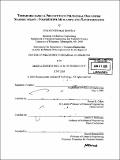Thermomechanical properties of polyhedral oligomeric silsequioxane- poly(methyl methacrylate) nanocomposites
Author(s)
Kopesky, Edward Thomas
DownloadFull printable version (12.96Mb)
Other Contributors
Massachusetts Institute of Technology. Dept. of Chemical Engineering.
Advisor
Robert E. Cohen and Gareth H. McKinley.
Terms of use
Metadata
Show full item recordAbstract
Poly(methyl methacrylate)s (PMMA) containing polyhedral oligomeric silsesquioxane (POSS) nanoparticles (d [approx.] 1.5 nm) were subjected to heological, mechanical, and morphological tests to determine the effects that POSS has on the melt-state and solid-state properties of this commercially important amorphous polymer. The effect of POSS on the rheological properties varied depending on the type of POSS cage and whether the POSS was covalently tethered to the PMMA backbone. A highly miscible acrylic-POSS species plasticizes PMMA, decreasing the glass transition temperature by approximately 10⁰C at a loading of 10 vol%. An essentially immiscible POSS species (cyclohexyl-POSS) does not alter the ... of PMMA but is able to decrease slightly the zero shear-rate viscosity at low loadings. Incorporating a POSS filler (isobutyl-POSS) into an isobutyl-POSS-PMMA copolymer causes a significant increase in viscosity at all loadings. The addition of POSS fillers to PMMA leads to an enhancement in the toughness in both slow-speed tension (strain rate = ... ) and high rate split-Hopkinson pressure bar tests (strain rate = ... ). In particular, the combined addition of two distinct POSS species - one miscible, one immiscible - led to the greatest enhancement in toughness and excellent reproducibility. A four-fold increase in tensile toughness was observed through the use of these two disparate POSS species. (cont.) Polyhedral oligomeric silsesquioxane macromers were copolymerized separately with a glassy polymer [PMMA, ... = 104⁰C] and a rubbery polymer [Poly(n-butyl acrylate), ... = -52⁰C] to determine the effect of the polymer glass transition temperature on the ultimate properties of an acrylic copolymer. Copolymers of POSS and PMMA show a significant decrease in ... . Conversely, copolymers of POSS and poly(n-butyl acrylate) have significantly higher glass transition temperatures than the pure PBA. These also exhibit a more than two order of magnitude increase in the room temperature modulus measured in DMA and tensile tests. The increase in modulus was due to nanocrystallites of POSS within the butyl acrylate matrix.
Description
Thesis (Ph. D.)--Massachusetts Institute of Technology, Dept. of Chemical Engineering, 2005. Includes bibliographical references.
Date issued
2005Department
Massachusetts Institute of Technology. Department of Chemical EngineeringPublisher
Massachusetts Institute of Technology
Keywords
Chemical Engineering.